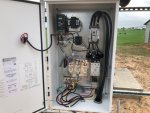I posted about this a few years back. The POCO made adjustments to their regulators and the situation did get better.
I will be looking at another location with the same type of customer equipment.
The POCO serves these accounts overhead Wye-Wye 480/277 with three transformers. This location is just a few miles of mainline from the substation PWT. The POCO primary tap this well is on is not well balanced and cannot be made any better unless the 3 phase primary line is redesigned and rebuilt.
Will a transformer change to Delta primary improve the voltage balance on the POCO secondary to the well and then improve the current unbalance issue?
This would be the first time for them to have a Delta primary bank on a four wire Wye line and will probably be a hard sell. The big POCO nearby serves all pump loads with delta primary transformer banks, because they always have.
Thanks,
https://xenforo.mikeholt.com/threads/submersible-tripping-out-on-current-unbalance.139721/

I will be looking at another location with the same type of customer equipment.
The POCO serves these accounts overhead Wye-Wye 480/277 with three transformers. This location is just a few miles of mainline from the substation PWT. The POCO primary tap this well is on is not well balanced and cannot be made any better unless the 3 phase primary line is redesigned and rebuilt.
Will a transformer change to Delta primary improve the voltage balance on the POCO secondary to the well and then improve the current unbalance issue?
This would be the first time for them to have a Delta primary bank on a four wire Wye line and will probably be a hard sell. The big POCO nearby serves all pump loads with delta primary transformer banks, because they always have.
Thanks,
https://xenforo.mikeholt.com/threads/submersible-tripping-out-on-current-unbalance.139721/




